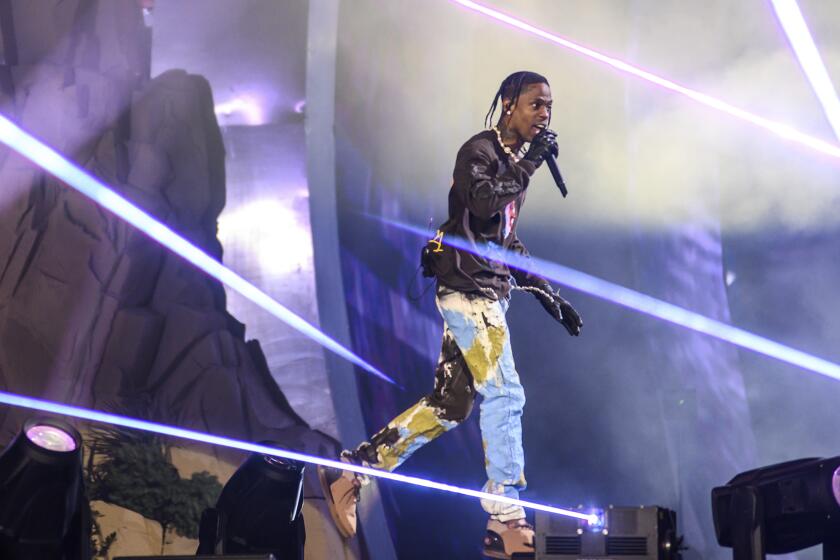Review: Matmos opens ‘perceptual pathways’ at Masonic Hall
On Monday night at the Masonic Hall within the Hollywood Forever Cemetery, about 200 people witnessed the results of what electronic musician M.C. Schmidt described as “experiments in psychic research.” As one half of the Baltimore-based duo Matmos, Schmidt relayed that his studies indicated that, among other things, after being exposed to their methodology, “a lot of people see green triangles.”
Indeed, Schmidt and bandmate Drew Daniel had offered evidence to open their performance in the form of an engaging, bouncy track called “Very Large Green Triangles” from their new album, “The Marriage of True Minds.” Created with the aid of what Daniel described in the liner notes as “a classic para-psychological experiment,” the musical foundation of “Green Triangles” involved exposing a subject to white noise and red light “in order to permit other, possibly weaker perceptual pathways to open up.”
Matmos then translated into sound these mysterious traveling perceptions, and released the nine pieces as “True Minds.” The group performed a number of pieces from the record Monday, and what arrived were swirls of glitchy, rhythmic electronic tones teaming with percussion, samples, keyboards, electric guitar, the rubber-squeak of Schmidt “playing” a blown-up balloon, an autoharp, musical triangles, meditation bells, amplified and manipulated water bubbles and a mysterious black rectangle the size of a deck of cards that spit out organized hiss.
PHOTOS: Arts and culture in pictures by The Times
Scary stuff, perhaps, but not in the versatile hands of Matmos, or within the cavernous Masonic Hall, where said “perceptual pathways” became grand boulevards. Accompanied by members of touring companions/collaborators Horse Lords, the group crafted waves of patterned, and at times remarkably unpatterned, noise. At its best, as on “Green Triangles,” “Aetheric Vehicle” and the nearly 10-minute “Yield to Total Elation” (from their album “The Civil War”), the group delivered vastly structured aural experiments, much of it driven by four-on-the-floor stomp.
For 18 years, Matmos has pushed at the experimental edges of academic “brain music” and performance by harnessing the oft-heavy body music of techno, house and various permutations of electronic dance music. Academics during daytime hours -- Daniel is an assistant professor of English at Johns Hopkins University -- they’ve married the mind and body through gigs both in fancy rooms and scuzzy clubs. At Disney Hall in 2009, they performed on a remarkable bill that included Mike Einziger, the Kronos Quartet interpreting minimalist master Terry Riley and the composer himself improvising on the grand organ. They’ve both scored gay porn films and made music alongside performance artist Marina Abramovic.
At the Echo in 2010, the pair teamed with New York group So Percussion for a performance that featured members crafting tiny rhythms with the spines of an amplified cactus. I was visiting San Francisco in 2004 when the pair, commissioned by the Yorba Buena Center for the Arts, made music based on the notion of work; for a number of weeks, Schmidt and Daniel, dressed in suits, clocked into a gallery space at 9 a.m. and crafted improvised music with kindred spirits until 5 p.m. (with time off for lunch, of course). The results were captivating, as was their 2008 gig at the Echoplex in support of their transcendent work for analog synthesizers, “The Supreme Balloon.”
Among these many experiences, the Masonic gig was the noisiest, had the most electric guitar in it and felt most like a rock concert. Horse Lords made this happen; after performing a stunning opening set, various members of the Baltimore guitar, bass and double-drummer band joined with Matmos to help studio recordings such as “Total Elation” work as live compositions. During “E.S.P.,” a cover of a song by the British punk band Buzzcocks, the venue erupted with deconstructed, black-metal suggestive guitar distortion as Matmos tore apart the song and stitched it back together as if with copper wire and lightning bolts.
Dots of rhythm were penetrated by the clear strike of bells and triangles in “Aetheric Vehicle.” For “Lipostudio ... and So On,” dance-floor beats sprang from a recording, as Schmidt described it, of a Southern California liposuction surgery; he employed a straw and a bowl of water to add texture to the sounds of this procedure.
As an encore, Daniel queried the crowd: “Disco or lounge?”
Disco won by a landslide -- and their version of it, the new “Tunnel,” was packed with so many cascading sonic boulders and gravelly, jagged guitar strums that it nearly sounded like one too.
ALSO:
Album review: Atoms for Peace’s ‘Amok’
Goldenvoice announces Coachella warm-up shows
Father of 9-year-old rapper Lil Poopy investigated over videos
Follow Randall Roberts on Twitter: @liledit
MORE
INTERACTIVE: Christopher Hawthorne’s On the Boulevards
VOTE: What’s the best version of ‘O Holy Night’?
PHOTOS: Arts and culture in pictures
More to Read
The biggest entertainment stories
Get our big stories about Hollywood, film, television, music, arts, culture and more right in your inbox as soon as they publish.
You may occasionally receive promotional content from the Los Angeles Times.






